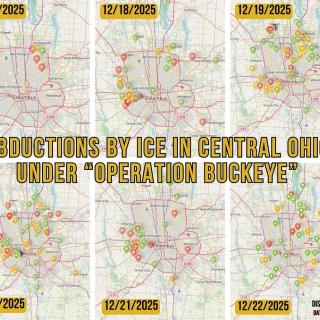Donald Trump received the highest Republican presidential vote total in Lake County, Ohio since George Herbert Walker Bush whipped Mike Dukakis in 1988. Trump beat Hillary by 15 points in that county. The Lake County News Herald pointed out that “Trump won in many communities that had traditionally voted for Democratic candidates.”
By contrast, Barack Obama lost in Lake County by less than one percent of the vote in 2012. Bill Clinton only lost by three points in that county in 1992 to Bush the Elder. Obama won 16 counties in Ohio, Hillary Clinton only won seven.
Various polls indicate that Ohio is in play once again as a swing state for the 2020 election. A recent Emerson poll of Ohioans revealed that 47 percent of Ohio voters supported impeachment while only 43 percent opposed. In a recent Baldwin Wallace University poll, Trump is trailing a hypothetical “or any” Democratic candidate by five points, with 16.3 percent undecided.
Will your vote be counted?
But, even if Trump’s popularity is waning in Ohio, can we trust that our votes will be counted properly? As the AP pointed out before the November midterm election, the country’s election integrity is in the hands of private companies.
Fortunemagazine in October 2019 ran the following article: “What battleground states need to do to prevent voting machine hacking in 2020.” The article pointed out that 92 percent of the country’s voting machine market is dominated by the Big Three: ES&S, Dominion, and Hart Intercivic. They reported that after the 2016 election, the Department of Homeland Security notified 16 states that used Direct Recording Electronic (DRE) voting machines – a term for paperless machines – that they had been targeted by hackers. But the machines had no paper trail, so there was no way to verify their vote count.
In addition to what Homeland Security and Boards of Elections need to do to secure our vote, what can the average voter do?
Ohio’s Voting Systems
According to Ohio Secretary of State Frank LaRose’s website, Ohio’s 88 counties use 13 different vote counting and tabulation systems. There’s no law in Ohio requiring a statewide voting system. All systems are provided by private corporate partisan for-profit companies whose software is proprietary and hence, secret. Here is a rundown of what machines are used in and around central Ohio and some other key counties
All Ohio counties still use electronic computerized voting machines. Anyone who has ever used a computer knows computer errors routinely happen. Computerized voting machines are no exception. The computerized voting machines, like all computer equipment, can have hardware design flaws, firmware errors (the software built into the machines), as well as software problems. Like any computers, there could be built-in manufacturer problems by accident, or back doors by design. Everyone is familiar with computer viruses as well. Computers can be old, have too much wear and tear, and dirt and dust can affect functioning. To simply assume that the computerized voting machines and tabulators are counting the votes correctly is counter-intuitive and goes against everything people know about computers in our high-tech age.
At the polling sites, human errors can occur when the electronic computerized pollbooks, voting machines and tabulators are set up. Computers can be damaged. They can be subject to electromagnetic interference during their operation. They can be incorrectly calibrated. Their input sensing function or reading ability can be distorted. They can experience random unintentional data corruption or electricity spikes. Problems can happen during software updates. New software patches are sometimes applied that can cause malfunction. How the machine records a voter’s choice can be incorrectly programmed into the machines.”
And these issues don’t include the obvious. With the most powerful office in the world at stake, insiders who have the right to secretly program our computerized voting machines could decide to manipulate the votes. Unauthorized programmers or hackers – in the United States – can do the same.
The last time an analysis of Ohio’s computerized voting machines was occurred was the Everest Study in 2007 by former Ohio Secretary of State Jennifer Brunner. As part of the study, the University of Pennsylvania’s Department of Computer and Information Science did a “security evaluation” of ES&S voting machines and found the following: “We found numerous exploitable vulnerabilities in nearly every component of the ES&S system.” ES&S is the largest supplier of computerized voting machines in Ohio.
Franklin County - What to watch out for:
Here in central Ohio, there are ES&S ExpressVote voting machines and DS200 tabulators. The ExpressVote machines were used in the last general election and have a ballot-marking device (BMD) option. After using the touchscreen to vote and completing the process on the screen, the voter can print out their vote and check its results for accuracy. Then the voter has the option to feed their print-out into the tabulator machine. Also, the Franklin County Board of Elections will offer a paper ballot option that is fed into the tabulator. Voters who choose the ExpressVote touchscreen will be asked after they submit their print-out in the tabulator, if they want again, to review their ballot.
An election security group in Pennsylvania is suing the state to stop the use of the ES&S ExpressVote XL machines after it made one of the worst errors in Quaker State history. Last November, the system showed Democratic judicial candidate Abe Kassis received only 164 votes out of 55,000 ballots cast. The machines had malfunctioned and only an audit of the paper backups proved Kassis actually won, the New York Times reported.
Check your paper ballot print-out.A recent study by the University of Michigan concluded that ballot-marking devices (BMDs) used by some 18 percent of the nation don’t have enough safeguards against hacking. Alex Halderman, University of Michigan computer science professor and co-author of the study, revealed the flaws.
Halderman and his team studied 241 people in a simulated election. Unknown to the study participants, Halderman had previously had the voting machine programmed to alter least one of their votes. The team observed that only 40 percent of the voter participants in the study actually bothered to review their ballots, and only seven percent who did told a pollworker something was wrong with their ballot.
Halderman found that although the voting machines provided a paper ballot print-out for review, the study revealed that voters do not check their ballots for accuracy and ballots could be potentially incorrect. The researchers concluded that in a close election, where hackers could potentially change two percent of the vote or less – it would be impossible to detect changes to ballots because of these voter habits.
Vote on paper.If a voter casts a paper ballot, the tabulator will indicate if there is an overvote – two people were chosen for the same race, or if there is an undervote – there is an election choice left blank.
ES&S pollbook backups needed. Another potential nightmare for voters is the electronic pollbook, that 27 percent of voters used in 2012, and according to the Federal Election Commission rose to 48 percent in 2016. In the old days, voters simply arrived at the polling site, signed their name in a large book of voter names. Now the worry is whether or not your precinct pollworkers are savvy enough to download the electronic pollbook software and get it to work with the tablet or computer. There are no regulations for electronic pollbooks. Theoretically they are used to speed things up, but when the technology breaks down, voting can completely come to a halt.
According to Joseph Lorenzo Hall, Chief Technologist at the Center for Democracy and Technology, these pollbooks greatly increase the probability of cyberattacks. Also, according to NPR, there is no federal regulation on these pollbooks – their operation or security. If the pollbooks go down as they did in a few precincts in Cincinnati during the 2018 midterm elections – where workers were unable to bring them back up (and unaware that paper pollbook backups were present at the precincts) – there must be paper backups at the polling sites.
NPR reported that ES&S, that supplies the Franklin County electronic pollbooks, failed to provide enough bandwidth for Johnson County, Indiana in the last general election that caused the electronic pollbooks to slow down to the point they were barely working.
Licking County - What to watch out for:Licking County uses the same systems as Franklin County and would experience the same kind of problems.
Delaware County - What to watch out for:The problematic Delaware County, suspected of cheating in the 2004 presidential election, has selected Unisyn OpenElect Voting Optical (OVO) voting machines. These are considered to be one of the better systems with a full-page dual-sided optical scan of the ballot. Voters will manually write their choices on a paper ballot with a pen.
Check your ballot before you submit:Double check your vote before you feed your ballot into the tabulator.
Ballot images saved:Election integrity activists are also working to ensure the Delaware County voters’ ballots are saved in case there is a later recount.
Fairfield County - What to watch out for:Fairfield County uses DRE Dominion Image Cast X (ICX) voting machines with a V-PAT. Freedomtotinker website points out that the ICX has a design flaw: "After you mark your ballot, after you review your ballot, the voting machine can print more votes on it." Also, they use KNOWiNK eelctronic pollbooks, The Government Technology, govtech.com website observed that failure to properly connect to voting machine printers and inadequate election night reporting were among the flaws in the pollbooks.
The Philadelphia Inquirer echoed this warning about the KNOWiNK pollbooks with the following headline from last November’s municipal election: “Philadelphia says new electronic pollbooks don’t work.” The Inquirer listed the following problems: “…failure to properly connect to voting machine printers and inadequate election night reporting.”
ES&S pollbook backups needed. If the KNOWiNK pollbooks won’t work at the polling site, voters should remind their election officials that there is a paper backup.
Lake County - What to watch out for:Lake County is the only Ohio county currently using the older ES&S iVotronic voting machines. The Brennan Center reported a problem with vote flipping in the 2008 election on these machines. Election integrity activists refer to the machine as “Flipper.” South Carolina voters sued their state because the voting machine is a DRE which is a direct reporting machine with no paper trail. The election integrity community finds the machine vulnerable to hacks and viruses. Missing, phantom, uncounted and uncountable votes are other complaints. In 2008, 5000 phantom votes were found in Colorado in a iVotronic machine.
Trump’s 2016 victory in Lake County is suspect because of the old and very insecure iVotronic machines used there. Despite exit polls indicating a very close race in 2016 in Ohio, with Trump winning by only half a point, his official vote tally bested Hillary by 8 points. This discrepancy is well outside the margin of error and would serve as a red flag that someone or something tampered with election results. If Ohio were outside the borders of the United States, the U.S. State Department would not have certified the 2016 election results as the results of a free and fair election.
The exit polls also showed Trump losing Wisconsin, Michigan, Pennsylvania, North Carolina and Florida – states he narrowly won.
Voters must be aware of the problems with our computerized voting system and be prepared to take action and ensure their votes are properly cast and counted.
Learn how to ensure your vote is counted at the TrustVote “Protect Your Vote” seminar that is free and open to the public on Saturday, February 15, from 1-4 p.m. at the Vanderelli Room, 218 McDowell Street with this author and including featured speaker Wade Rathke, Chief Organizer of ACORN International.
Protect Your Vote
TrustVote Event
Saturday, February 15, 1-4pm
Vanderelli Room, 218 McDowell St., Franklinton




